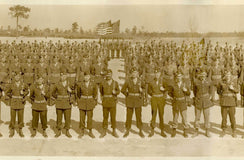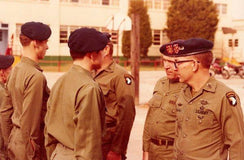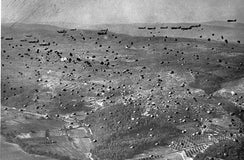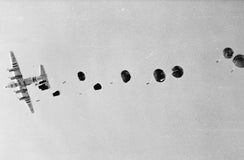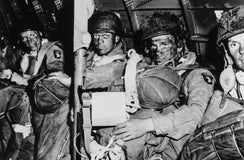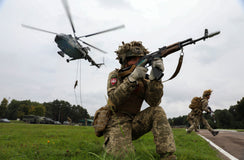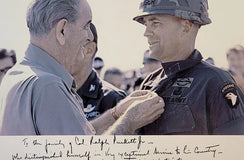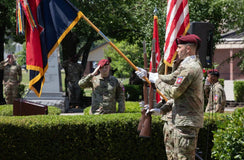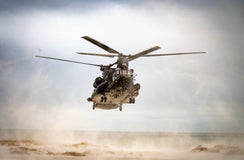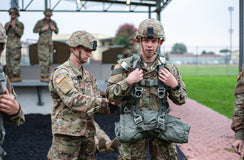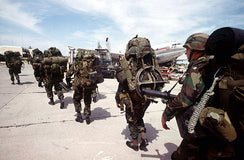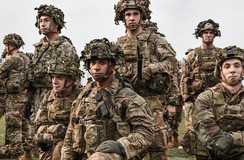Unmanned Aerial Systems Will Become Integral to Airborne Operations
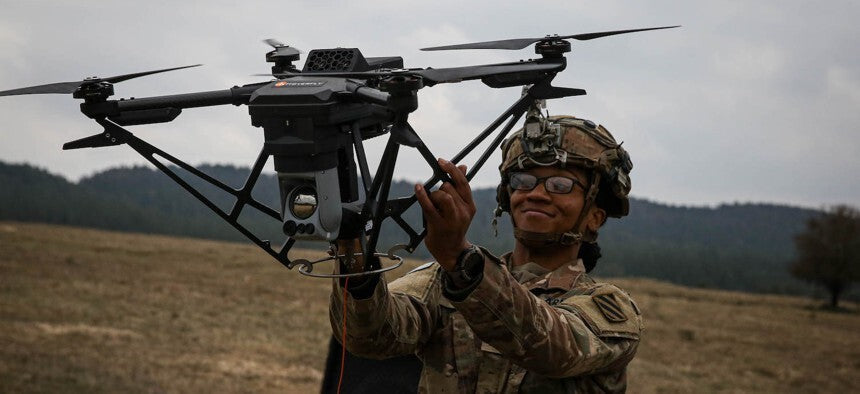
"Attack your enemy where he is unprepared; appear where you are not expected."
Sun Tzu
Airborne Operations Have Changed
Integrating Unmanned Aerial Systems (UAS) into airborne operations has not just reshaped tactical strategies and operational capabilities in modern warfare, but it has also provided a significant strategic advantage.

This paradigm shift, as seen in recent conflicts like the ongoing situation in Ukraine, where UAS has played a pivotal role, has elevated the capabilities of airborne operations. In a nutshell, the airborne world we once knew is forever gone and will never be the same, but it's a change that we can harness to our advantage.
The utilization of UAS in airborne operations has brought about significant advancements in reconnaissance, surveillance, and target acquisition (RSTA) capabilities. Armed with sophisticated sensors and real-time data transmission capabilities, UAS provides airborne units with enhanced situational awareness and the ability to gather crucial intelligence on enemy positions, movements, and activities. This integration has allowed airborne forces to conduct more precise and effective missions, including targeted strikes on high-value targets and support for ground forces during combat operations.
One inspiring example of the successful integration of UAS into airborne operations is the use of drones by Ukrainian forces in their conflict against separatist groups and Russian-backed forces.

Ukrainian military units have leveraged UAS to gather intelligence, monitor enemy movements, and conduct reconnaissance missions in hostile territories. This success story is a testament to the effectiveness of UAS integration, inspiring confidence in the potential of this technology.
However, integrating UAS into airborne operations also presents challenges and vulnerabilities. The increased reliance on unmanned systems introduces new concerns regarding cybersecurity, electronic warfare, and the potential for enemy exploitation of UAS technology. For instance, there have been instances where hostile forces have successfully intercepted and manipulated the data transmitted by UAS, leading to compromised missions. This highlights the need for robust countermeasures and protective measures to safeguard UAS assets and maintain operational integrity.
Despite these challenges, the evolution of UAS technology continues to drive innovation and transformation in airborne operations. Advancements such as autonomous flight capabilities, swarming tactics, and improved communication systems are shaping the future of airborne warfare. For instance, the development of autonomous UAS that can operate without human intervention could revolutionize airborne operations, offering new possibilities for strategic maneuverability and mission success.
82nd Leads the Way in Groundbreaking Shift in Tactics
The U.S. Army is escalating its counter-drone initiatives to combat the increasing drone threat.

This comprehensive strategy includes soldier training, deploying anti-drone trucks in Ukraine, and arming platoons with handheld and electronic warfare systems to neutralize drones weighing between 250 grams and over 1,000 pounds. Maj. Gen. Sean Gainey of the Joint Counter-small Unmanned Aircraft Systems Office (JCO) has equipped two divisions with these capabilities and plans to extend them to the platoon level.
The 82nd Airborne and 1st Cavalry divisions have the autonomy to assign soldiers to operate these systems, which are not limited to specific military roles. Furthermore, the Army is developing protocols to ensure anti-drone operations can be safely conducted in busy airspaces, as highlighted by Lt. Col. Johnathan Hester of the JCO. This reflects a significant shift towards a more versatile and responsive military force capable of addressing modern aerial threats.
It is no coincidence that the 82nd Airborne Division is the first unit in the Army to test and use small drones in their operations.
Their versatility and professionalism make them perfect candidates to test new concepts, doctrine, and equipment. Drawing inspiration from Ukrainian defense strategies against the Russian offensive, the troops stationed at the North Carolina base are leading the initiative as the “inaugural group” to receive training in munitions deployment via compact drones, as informed by Lt. Gen Christopher Donahue, commander of the 18th Airborne Corps.

The renowned commander explained in a media session that they have innovated by creating the necessary components through 3-D printing to manage different explosives. These components have been trialed and approved and are now integrated into their training regimen, including live-fire exercises.
The 82nd Airborne Division also collaborates with Fort Liberty Range Operations and other units stationed at the base to develop "realistic and challenging conditions." This initiative is part of an effort to comprehensively incorporate unmanned aerial systems (UAS) into all training exercises, ensuring that troops are well-prepared to operate and interact with these systems in various simulated combat scenarios.

The 101st is “Transforming-in-Contact”
In the future, U.S. Army units may synchronize all tiers of their indirect weaponry, from mortars to missiles, with various types of unmanned aerial systems (UAS), according to the commander of the 101st Airborne Division. “You could see those small UAS tied to the employment of mortars, and you could see those medium UASs tied to artillery, and those larger UAS could be tied to air-launch effects and other higher-order precision munitions,” Maj. Gen. Brett Sylvia illustrated this vision at a media event, explaining these concepts are being tested and could be integrated across all indirect fire efforts.

The 101st Airborne Division is actively testing new technologies as part of Gen. Randy George’s initiative to transform the Army's capabilities by directly fielding innovations to specific units. The concept is dubbed "Transforming-in-Contact," the Army is exploring innovative procurement strategies to expedite the delivery of new equipment to the 101st Airborne Division and other units. This approach signifies a shift from traditional acquisition methods, often involving buying substantial quantities of a system from a single manufacturer and then slowly distributing it throughout the forces.
General George has emphasized the necessity of transforming the Army's equipment strategy. He highlighted the rapid evolution of technological needs observed in Ukraine, underscoring the urgency of providing soldiers with current and adaptable technology that can be updated to meet emerging threats.
In line with that concept, the division's second brigade has been transformed into the Army's inaugural Mobile Brigade Combat Team, utilizing cutting-edge technologies like the Army's ATAK mission planning software across various command levels. This brigade also serves as a testing ground for new technologies within its Multifunctional Reconnaissance Company.

Sylvia further mentioned that Army units could restructure to maximize drone usage. For instance, infantry squads could deploy small drones for reconnaissance, allowing soldiers such as riflemen to add drone operations to their primary duties. These small drones enable squads or platoons to gain visibility beyond immediate geographical obstacles.
The evolving drone operations in the Middle East and their tactical application in the conflict between Ukraine and Russia are reshaping the Army's approach to warfare readiness. Since the onset of hostilities, Ukraine has been utilizing economical, readily available drones to deliver munitions on Russian forces, targeting a spectrum from armored vehicles and air defense units to camouflaged infantry in trenches. The aerial footage showcasing these drones at work has come to represent the modern face of warfare.
Introducing the Replicator Initiative
But how does a large organization like the U.S. Army implement changes at a pace that can defeat or at least keep pace with its main competitors? One exciting solution has been introduced as the Replicator Initiative. This initiative, spearheaded by the Department of Defense (DoD), is streamlining a process to quickly identify and deliver essential capabilities that substantially impact operations directly to military personnel, both rapidly and on a large scale. At the same time, the Army has decided to discontinue the Future Attack Reconnaissance Aircraft (FARA) program, which had already spent several billion dollars. A shift of Army policy, alongside a series of modifications to aviation acquisition strategies.
This initiative has led to the creation of an investment strategy defined by the warfighter's needs. It includes the development of new operational concepts, the undertaking of prototyping and experimentation, and the establishment of fast-track acquisition channels. These efforts are designed to pave the way for introducing new capabilities, systems, and partnerships within the industry. The DoD is capitalizing on emerging and traditional defense technology sources to incorporate new technologies and approaches. This strategy aims to maximize military effectiveness and simultaneously broaden and fortify the network of U.S. industrial and technological enterprises.
For the fiscal year 2024, around $500 million has been allocated by DoD, which enables the Defense Innovation Unit to facilitate the process of acquiring commercial such as unmanned aerial systems. The sustainability of the Defense Innovation Unit's initiative to evaluate and approve commercial drones for defense purposes, and to simplify the procurement process for military entities, which could be jeopardized by inconsistent financial support if those incentives are not provided.
The Pentagon has announced that the Switchblade-600, a loitering munition produced by AeroVironment Inc., is the inaugural weapon revealed to be included in the Replicator initiative. While this project seeks to swiftly field many military drones, the Switchblade-600 has become well-known due to its use by the Ukrainian forces for engagements against Russian units. While it is the initial weapon unveiled within the initiative, additional batches and systems are anticipated. The first batch also encompasses undisclosed naval surface assets, additional aerial drones, and counter-unmanned aerial systems (c-UAS).
The DIU, an arm of the Pentagon that collaborates with military branches to deploy commercial technologies, initiated the Blue UAS program in 2020. This program was designed to facilitate a more efficient method for the Department of Defense to authorize domestically produced drones for defense applications. Without this program, departments wishing to acquire commercially available small unmanned aerial systems (UAS) would be compelled to navigate the complexities of existing DoD procurement frameworks or request an exemption — a burdensome and lengthy endeavor.
UAS as a Branch: How Could Airborne Ops Synchronize with the UAS Branch?
Faced with the challenge of countering Russia's extensive collection of cruise and ballistic missiles, Ukraine has concentrated its efforts on the development and manufacture of long-range drones. This strategic pivot allows Ukraine to launch counterattacks against Russia, which has conducted bombing raids throughout the 26-month invasion.
This week, the leader of Ukraine's national defense company announced that Ukraine has achieved a production rate of deep-strike drones comparable to Russia's. This marks a significant milestone, as Ukraine claims to have attained an equal footing with Moscow in terms of a crucial weapon category utilized for distant assaults.
This statement also corresponds with a presidential decree issued by President Volodymir Zelenskyy on February 7th, 2024, which starts the process of establishing a new branch of the Armed Forces of Ukraine (AFU): The Unmanned Systems Forces. In his address, he stressed the importance of this project being a near-term objective rather than a matter of the future since the employment of drones “have proven their effectiveness in battles on land, in the sky and at sea. Ukraine has truly changed the security situation in the Black Sea with the help of drones. Repelling ground assaults is primarily the task of drones. The large-scale destruction of the occupiers and their equipment is also the domain of drones.”
This is a historic decision for the armed forces worldwide, Ukraine being the first country globally. The goal of this decree is for the Ministry of Defense and AFU to identify particular staff positions for UAS ops, increase production to 1 million by 2024, and utilize practical training. Moreover, the goal is to improve planning and quality of logistics so that the Unmanned Systems Forces can become an integral part of the AFU. The National Security and Defense Council of Ukraine will assess the final report for consideration and decision-making. However, the question is not if they will implement the UAS Forces but how and when. If such a change is initiated in the middle of a war, then it must happen.
UAS will become integral to the Paratroopers
In conclusion, integrating Unmanned Aerial Systems into airborne operations represents a significant paradigm shift in modern warfare. While providing enhanced capabilities in reconnaissance and surveillance, using UAS also presents challenges that require careful consideration and adaptation. As technology continues to evolve, the role of UAS in airborne operations will likely continue to expand, shaping the dynamics of future conflicts and the strategies employed by airborne forces worldwide.

Check out this video from the 2nd Brigade's Combat Team Multifunctional Reconnaissance Company, in which they show their skills in Operation Lethal Eagle.


